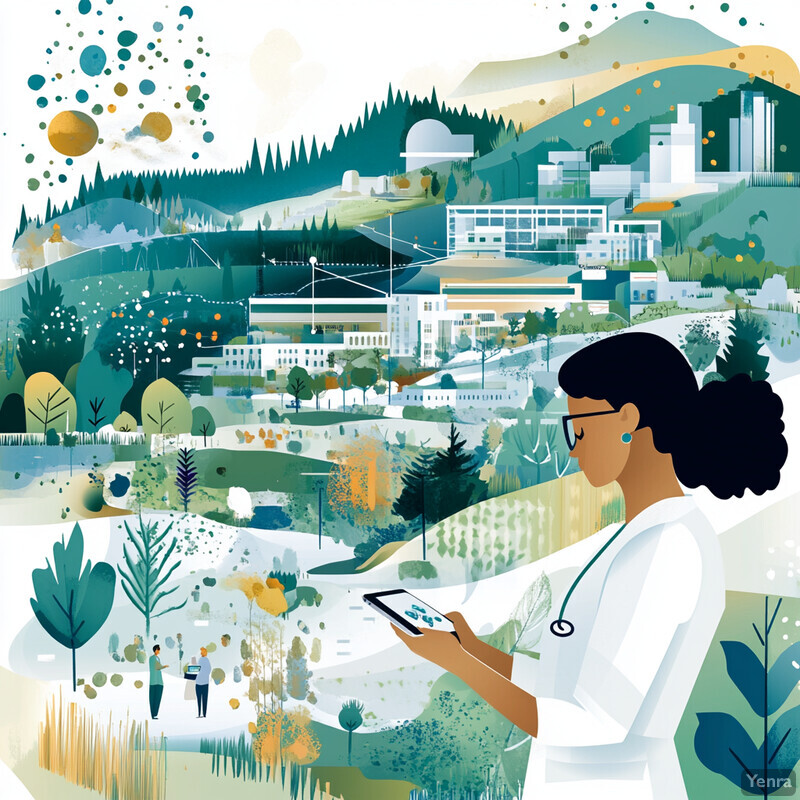1. Enhanced Disease Surveillance and Early Detection
AI enables real-time monitoring of health data (e.g. clinical records, social media, search trends) to flag unusual disease patterns earlier than traditional methods. For example, models that fuse search/query and social media data have forecasted influenza outbreaks 1–2 weeks before official reports. Early anomaly detection (e.g. spikes in symptom-related posts or environmental signals) can trigger rapid investigation and targeted testing. These AI tools help policymakers preempt outbreaks by suggesting timely interventions (like localized vaccination) based on detected signals. By providing ongoing situational awareness, AI-supported surveillance helps contain spread before epidemics grow.

Studies demonstrate that AI improves outbreak prediction and timeliness. A 2023 study found machine learning models (random forest, XGBoost, etc.) predicted COVID-19 outbreak start times in South Korea with over 94% accuracy. The model identified seven estimated outbreaks between Mar 2020 and Oct 2022, versus only five officially reported, suggesting hidden early transmission was detected. Editorial analyses note that combining AI with data sources (e.g. search queries, Twitter posts, emergency visits) allowed influenza outbreaks to be predicted 1–2 weeks earlier than conventional surveillance. For instance, correlations between flu-related tweets and case data provided early warnings of rising cases. These findings indicate AI-driven surveillance can reliably spot emerging disease clusters, enabling health officials to act sooner.
2. Predictive Modeling for Resource Allocation
AI models forecast the future demand for health resources and guide their distribution. By simulating disease spread and healthcare usage, AI helps planners decide how many vaccines, hospital beds, or ventilators will be needed in each region. For example, during a flu season AI can project case surges in different counties, enabling re-routing of staff and supplies in advance. These predictive forecasts let policymakers allocate budgets and equipment efficiently (e.g. shift ventilators to expected hotspots). Ultimately, AI-driven models support “what-if” scenarios (e.g. with or without a certain intervention) so decisions on resource use are based on data-driven predictions of cost and benefit.

Recent work shows AI-based forecasting improves allocation planning. Ahmadini et al. (2025) developed a neural network framework integrating case, mobility, and environmental data for COVID-19 and achieved superior forecasting accuracy compared to traditional models. This approach enabled dynamic allocation of resources: the authors reported “significant improvements in forecasting performance and healthcare preparedness compared to traditional models”. In practice, this means AI-informed plans (for beds, staff, equipment) better matched actual needs. A scoping review of COVID-19 response literature also concluded that AI/ML “has the potential to improve efficacy in resource distribution, especially during emergencies”. For example, one hospital system’s use of predictive analytics for influenza vaccine ordering led to far more accurate order quantities than the prior rule-of-thumb method. These studies confirm that AI forecasts can guide smarter stocking of vaccines, supplies, and personnel.
3. Improved Targeting of Public Health Interventions
AI helps identify which communities or groups will benefit most from specific interventions (e.g. vaccination drives or outreach campaigns). By analyzing data (health records, demographics, behavior), AI can highlight hotspots and vulnerable subpopulations. For example, models may pinpoint neighborhoods with low immunization rates or high diabetes risk so programs can be focused there. This targeting ensures interventions (e.g. free clinics, information campaigns) go where they’ll have the greatest impact. AI thus makes policies more efficient by matching resources to the highest-need areas and tailoring strategies to local conditions.

Studies illustrate AI’s capability to pinpoint high-risk groups. Olawade and colleagues (2023) review how predictive analytics can “identify high-risk populations” and support development of “targeted interventions”. In practice, this means machine learning can analyze EHR and social data to find communities with, say, low vaccine uptake or high exposure risk. For instance, the same review notes that AI can determine “which specific population groups would benefit from targeted interventions (such as vaccinations for groups more vulnerable to specific diseases)”. Other work shows AI derived from mobility and demographic data can map outbreak risk by age or income level, guiding localized public health actions. In sum, AI-driven analysis provides evidence on who and where to target, so that interventions such as testing, education, or subsidies are directed to reduce inequities and maximize health gains.
4. Data Integration from Multiple Sources
AI excels at merging diverse data (e.g. clinical records, environmental sensors, social media) to give a comprehensive view of health issues. For public health analysts, this means combining hospital data with air quality indices, demographic databases, or even mobile phone movement patterns. Such integration uncovers links (e.g. pollution spikes and asthma visits) that individual datasets alone would miss. Policies can then be based on this fuller picture – for example, linking heat maps of asthma rates to neighborhood factors, or coordinating disease reports across clinics. AI-powered systems make it practical to harmonize and analyze these otherwise separate sources in one framework, improving the evidence base for decisions.

Researchers emphasize AI’s role in multi-source integration. A 2024 scoping review found machine learning and natural language processing dramatically improve the integration of social determinants data with clinical records. The authors note that AI provides a “transformative role” in modeling and analyzing factors like socioeconomic status, behavior, and environmental exposures within health databases. In emergency medicine, for example, NLP tools have merged electronic health records with socioeconomic surveys to better assess patients’ social needs. Other work demonstrates AI combining satellite sensor data, weather models, and health registries to forecast disease spread (e.g. integrating climate and case data to predict mosquito-borne illness). These cases show AI makes it feasible to link heterogeneous data streams into unified analyses, enabling more data-driven policies.
5. Behavioral and Social Determinants Analysis
AI methods examine how behaviors and social factors (like income, housing, mobility) influence health outcomes, informing policies that address root causes. For example, AI can analyze mobility data or social media trends to study how social behaviors affect epidemic spread. By identifying links (e.g. between unemployment rates and depression rates), AI helps policymakers design interventions tackling social determinants. It can also highlight lifestyle risk factors (such as diet or smoking patterns) correlated with disease incidence, guiding targeted education or community programs.

Experts note AI is promising for analyzing social determinants of health (SDOH). A perspective points out that AI can evaluate “the impact of social determinants of health on health outcomes” by integrating diverse data. For instance, machine learning models can combine census data, neighborhood surveys, and health outcomes to reveal how poverty or education gaps contribute to illness rates. Another review highlights that AI and ML are instrumental in integrating and modeling SDOH information within health data, thereby uncovering patterns (like areas where lack of transport or healthy food access drive poor health). By illuminating these hidden drivers, AI-driven analysis enables policymakers to design social policy measures (e.g. housing initiatives, income support) as part of public health strategy.
6. Enhanced Contact Tracing and Epidemic Control
AI accelerates contact tracing by automating identification of transmission chains and predicting who might have been exposed. For example, AI can analyze cell-phone mobility or credit card data to infer contact networks faster than manual interviews. It can prioritize likely transmission links, enabling quarantine measures to focus on those most at risk. AI also supports epidemic control by rapidly evaluating which control measures (testing, isolation, travel restrictions) will most reduce spread. Overall, AI tools allow faster, data-driven tracing and containment strategies, reducing outbreak size.

During early COVID-19 responses, AI tools aided tracing efforts. In China, AI-driven systems processed travel, social, and health data to map transmission paths. One report notes that deploying algorithms (including thermal imaging for fever detection and facial recognition to enforce quarantines) led to “significant reductions in transmission rates” within one month of the outbreak. These AI methods enabled authorities to quickly identify exposure hotspots and enforce isolation. In another study, deep learning models were shown to rapidly recommend combinations of interventions (masking, vaccination schedules, isolation) by simulating epidemic dynamics, demonstrating that AI-based planners can evaluate tradeoffs of multiple measures far more quickly than manual policy review. These capabilities enhance epidemic control by enabling efficient use of limited tracing and response resources.
7. Early Warning Systems for Food and Water Safety
AI analyzes monitoring data to flag contamination risks in food and water supplies before human health is affected. In food safety, machine learning can scan inspection and supply-chain data to predict where spoilage or pathogens may arise (e.g. identifying batches likely to harbor bacteria). For water safety, AI models combine sensor readings (like turbidity or bacteria counts) with weather and flow forecasts to predict contamination events. Such systems can trigger alerts (e.g. boil-water advisories) or targeted testing ahead of formal outbreaks, protecting public health proactively.

AI applications in food and water safety have shown concrete benefits. In food supply chains, machine learning models have been used to detect microbial contamination and spoilage from big data. For example, one review explains that ML algorithms can analyze production, transport, and storage data to flag likely contamination and automate traceability. This has helped preempt foodborne illness by pinpointing high-risk food batches. In water systems, a recent study used AI to forecast turbidity (a proxy for contamination) in New York City’s reservoirs. By combining streamflow forecasts with real-time sensor data, the model delivered “robust forecast for water quality” that was especially accurate during storms. This tool allowed authorities to anticipate water cloudiness events before they occurred, enabling timely adjustments to water supply management and public warnings.
8. Rapid Policy Impact Assessment
AI enables fast simulation of policy effects, allowing authorities to compare options quickly. For example, reinforcement-learning agents can simulate different intervention levels (e.g. varying degrees of social distancing or vaccination campaigns) and estimate resulting cases and costs. This lets policymakers see which combination of actions most reduces disease spread per dollar spent. Rapid assessment means policies can be adjusted on the fly as new data arrives (e.g. if cases rise unexpectedly). AI-driven models thus accelerate what used to be slow scenario analysis, helping leaders choose effective policies in real time.

Recent studies apply AI to evaluate policy packages for epidemics. Mai et al. (2023) used deep reinforcement learning to propose tailored epidemic control strategies. Their algorithm jointly modeled interventions (mask mandates, vaccination rates, isolation) at continuous levels and computed trade-offs in disease reduction vs. costs. Such models can rapidly search a large “policy space” to identify optimal plans, speeding up impact assessment. Another example is an agent-based simulator powered by Q-learning, which tested different vaccination and lockdown scenarios and identified strategies that minimized infections and economic loss (one study found early targeted lockdown was both cheaper and more effective than blanket measures). These AI frameworks demonstrated that data-driven policy simulations can quantify likely outcomes much faster than traditional manual planning.
9. Drug Resistance and Pathogen Evolution Forecasting
AI analyzes genetic and clinical data to predict how pathogens will evolve drug resistance. For example, machine learning can scan bacterial genome sequences to detect emerging resistance mutations, alerting policymakers when first-line antibiotics are losing effectiveness. AI models can also forecast trends (e.g. rising antibiotic use in one area leading to future local resistance). This allows health officials to update treatment guidelines proactively (e.g. switching to alternative drugs) or invest in stewardship programs. Essentially, AI provides early warning on resistance patterns so policies (like prescribing regulations) can adapt quickly.

Studies confirm AI’s power in resistance prediction. A 2024 review reports that AI/ML models (e.g. support-vector machines) are increasingly used to predict pathogen resistance based on genomic features. For instance, expanding the set of candidate resistance genes (pan-genome methods) and using SVMs significantly improved prediction of bacterial antibiotic resistance. Other work developed an XGBoost model using proteomic (MALDI-TOF) data to “rapidly predict dual resistance” in Staphylococcus aureus, facilitating fast detection of multi-drug resistant strains. More broadly, AI surveillance systems can “analyze vast amounts of data to identify new resistance patterns and potential hotspots,” enabling health agencies to preempt outbreaks of resistant infections. This capability helps update treatment policies before widespread resistance emerges.
10. Identification of Inequities and Disparities
AI can reveal health inequities by analyzing demographic and outcome data. For example, it can detect that certain minority or low-income groups have worse outcomes (e.g. higher disease rates or hospitalizations) even after adjusting for clinical factors. Such insights guide policies to close gaps, like expanding services in underserved areas or addressing bias in care. By scanning patterns (for instance, differences in treatment rates by race), AI flags disparities that may not be obvious, prompting targeted interventions (e.g. mobile clinics in neglected communities).

Experts argue AI is vital for health equity analysis. Green & Robinson (2024) explain that AI can “dissect the multifactorial social, genetic, and environmental factors of health disparities” by mining large datasets. AI methods can uncover hidden correlations – for example, linking neighborhood poverty data to poorer health outcomes – that traditional stats might miss. In practice, this means ML models might analyze electronic health records alongside social variables to identify which groups (by race, zip code, etc.) have elevated risk of adverse outcomes. Policymakers can then address these specific inequities (like ramping up resources in high-risk locales). By shining light on systematic gaps, AI-driven analysis helps ensure policies are equity-focused.
11. Enhanced Mental Health Policy Development
AI supports mental health policy by identifying population-level risks and evaluating interventions. For instance, AI can process social media or clinical text data to detect emerging trends in depression or anxiety, allowing early response (like expanding counseling services in hotspots). It also prioritizes high-risk individuals (e.g. flagging veterans at suicide risk) so resources can target them. Simulations of interventions (e.g. online support programs) can be tested via AI to estimate their impact on community well-being. In sum, AI helps policymakers anticipate mental health needs and allocate resources (therapists, campaigns) where they can prevent problems from escalating.

Research indicates AI can flag mental health risks from data sources. Cettlemens et al. (2023) note that “AI-enabled tools can prevent more severe mental illness…by identifying higher-risk populations” for early intervention. For example, AI algorithms applied to electronic health records or text have been able to detect early cognitive decline and even child maltreatment signals, both relevant for long-term mental health. These tools allow health systems to direct services (like counseling) to those identified at risk. Additionally, natural language processing of social media posts has been used to estimate community stress or depression levels, informing public mental health measures. Such AI-driven insights improve the evidence base for mental health policies.